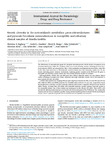2022-12-21Zeitschriftenartikel
Genetic diversity in the metronidazole metabolism genes nitroreductases and pyruvate ferredoxin oxidoreductases in susceptible and refractory clinical samples of Giardia lamblia
Saghuag, Christina S.
Gamlem, Astrid L.
Hauge, Kirsti B.
Vahokoski, Juha
Klotz, Christian
Langeland, Nina
Hanevik, Kurt
Aebischer, Toni
The effectiveness of metronidazole against the tetraploid intestinal parasite Giardia lamblia is dependent on its
activation/inactivation within the cytoplasm. There are several activating enzymes, including pyruvate ferre-
doxin reductase (PFOR) and nitroreductase (NR) 1 which metabolize metronidazole into toxic forms, while NR2
on the other hand inactivates it. Metronidazole treatment failures have been increasing rapidly over the last
decade, indicating genetic resistance mechanisms. Analyzing genetic variation in the PFOR and NR genes in
susceptible and refractory Giardia isolates may help identify potential markers of resistance.
Full length PFOR1, PFOR2, NR1 and NR2 genes from clinical culturable isolates and non-cultured clinical
Giardia assemblage B samples were cloned, sequenced and single nucleotide variants (SNVs) were analyzed to
assess genetic diversity and alleles.
A similar ratio of amino acid changing SNVs per gene length was found for the NRs; 4.2% for NR1 and 6.4% for
NR2, while the PFOR1 and PFOR2 genes had less variability with a ratio of 1.1% and 1.6%, respectively. One of
the samples from a refractory case had a nonsense mutation which caused a truncated NR1 gene in one out of six
alleles. Further, we found three NR2 alleles with frameshift mutations, possibly causing a truncated protein in
two susceptible isolates. One of these isolates was homozygous for the affected NR2 allele. Three nsSNVs with
potential for affecting protein function were found in the ferredoxin domain of the PFOR2 gene. The considerable
variation and discovery of mutations possibly causing dysfunctional NR proteins in clinical Giardia assemblage B
isolates, reveal a potential for genetic link to metronidazole susceptibility and resistance
Dateien zu dieser Publikation

